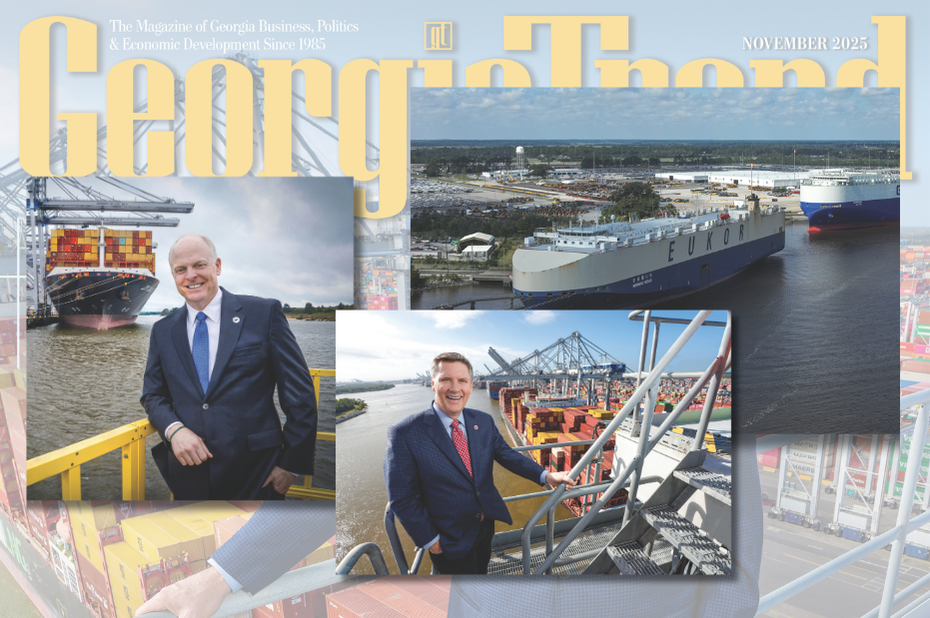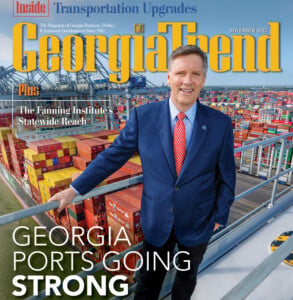Georgia Ports: On the World Stage
The Georgia ports are winning global business by investing in ongoing improvements to increase the state’s international connections and stabilize supply chains.
Just a few months ago, the 2024 Summer Olympics in Paris showcased how nations around the world can come together for a common purpose. That feeling of connection was evident in the athletes’ interactions with each other and our fascination with them. In some ways the Georgia Ports Authority (GPA) is like one of those elite teams of athletes we cheered – constantly performing at the highest level and demonstrating the power of connectivity among nations.
Created by the Georgia General Assembly in 1945, GPA operates deep water ports in Savannah and Brunswick along with inland terminals in Murray County and Bainbridge. The Port of Savannah is home to North America’s largest single-terminal freight container facility. The Port of Brunswick is the second busiest port in the U.S. for import and export of roll-on/roll-off (Ro/Ro) automotive and heavy machinery cargo and is the fastest-growing port for bulk imports and exports. Strategically, the GPA team is demonstrating its capabilities on the world stage.
“The number of services that we’re providing ocean carriers is increasing the global reach and connectivity of [the Port of] Brunswick, just like [what has] happened in Savannah over the last 20 years,” says Griff Lynch, GPA president and CEO. “We pride ourselves on [the Port of] Savannah being a gateway to the world and Brunswick is going in that same direction.”
Scoring Points

Consolidating Operations: In April, Wallenius Wilhelmsen (WW) Group signed a 20-year agreement with the GPA. Present were WW Chief Operating Officer Mike Hynekamp, WW CEO Lasse Kristoffersen, GPA Board Chair Kent Fountain and GPA President and CEO Griff Lynch. Photo credit: contributed
In fact, the Brunswick port had a record year in fiscal year 2024, which ended June 30. The port handled 876,000 units of autos and machinery, which was an increase of 21% over FY2023. Some of this increase was due to auto and machinery, cargo diverted to Brunswick in April and May from the Port of Baltimore where a 213-million-pound ship crashed into a bridge near the port, clogging a major shipping channel.
“But I would say the record that we achieved this year is more than just Baltimore,” says Lynch. “It’s the old adage, ‘If you build it, they will come.’ We built more space, and we had other cargos, other manufacturers, OEMs, actually use Brunswick and move their cargo from other ports to Brunswick. We have to thank our ocean carrier customers that helped make that happen. So everybody’s working on firing on all cylinders and Brunswick handling 876,000 autos and heavy equipment in FY24, it’s just massive.”
The improvements Lynch refers to include opening an additional 120 acres of Ro/Ro vehicle storage at Brunswick’s Colonel’s Island Terminal. With 300 more acres available for expansion, Colonel’s Island still has more room for growth than any U.S. auto port. Also, GPA added 640,000 square feet of warehousing and processing space for autos and machinery, increasing the terminal’s annual capacity 40% to 1.4 million units. These projects were part of $260 million GPA invested in Brunswick infrastructure and support GPA’s two-pillar strategy that consolidates all Ro/Ro and bulk cargo in Brunswick and all container cargo in Savannah.
Focused on Future Performance
The investments prompted longtime GPA customer Wallenius Wilhelmsen Group to ink a 20-year terminal agreement that consolidates logistics and port operations at the Brunswick port. (Norway-based Wallenius Wilhelmsen – or WW, as it’s known – is a leading shipping and logistics company that manages distribution of cars, trucks, rolling equipment and bulk cargo for customers worldwide. Its 125 shipping vessels traverse 15 trade routes to six continents and its inland distribution network is comprised of 66 processing centers and eight marine terminals, including Brunswick’s.)

Record Year: The Port of Brunswick handled 53,600 units of vehicles and heavy machinery in August, an increase of 1,700 compared to the same month last year. Photo credit: contributed
WW’s operations at the Colonel’s Island Terminal include ocean and inland transportation for car and truck imports along with vehicle and equipment processing such as installing customer-requested components, painting, washing and fumigation. For the company’s bulk cargo, GPA has upgraded the dock at Brunswick’s Mayor’s Point Terminal and built a new state-of-the-art 100,000 square-foot warehouse for storage.
According to Michael Derby, senior vice president of port, terminals and stevedoring – Americas for WW, the 20-year agreement with GPA gives WW customers the assurance that the South Atlantic market will have dependable infrastructure in Brunswick to handle their cargo well into the future. The company expects to bring 300 Ro/Ro ships to Brunswick this year.
In an email, Derby predicts, “The Brunswick port will continue to modernize its Ro/Ro capacity with a road widening project to improve efficiency within the port for the larger volume of cargo. Its berth expansion project to build a fourth berth will also be key for growing business in the future.”
Adding a fourth Ro/Ro berth at Colonel’s Island will allow more vessels to call on the port and accommodate larger ships carrying up to 7,000 vehicles. Accommodating these vessels will be easier when the turning basin at Colonel’s Island is expanded and the channel is widened. This is a federally funded project that Lynch believes will be completed in about 18 months.
“We see the population starting to shift to the Southeast, and we feel that Brunswick is very much poised to take on [that] population growth,” says Kent Fountain, GPA board chair. “Having partners like WW and having long-term partnerships is going to really make Brunswick a flagship facility.”
Enviable Scores
Farther up the Georgia coast, the Port of Savannah continues to have one of the nation’s best connectivity rankings. That means the more than 35 container ships dropping anchor every week at Savannah are carrying cargo that can get to 75% of the U.S. population within a three- to four-day rail trip. In FY24, those ships carried 5.25 million 20-foot equivalent container units (TEUs) handled at the Savannah port.
To accommodate the ever-growing number of ships calling on Savannah and their increasing size, GPA is making ongoing investments in terminal upgrades, on-port facilities and massive cranes for loading and unloading containers. As part of the port’s $1.9 billion master plan and infrastructure improvements that anticipate greater container volume, Savannah’s Garden City Terminal – the largest container terminal in the Western Hemisphere – was renovated to add another big-ship berth that will handle 1.5 million more TEUs. The terminal is now serving seven ships simultaneously with four of those having a massive capacity of 16,000 TEUs. Along with the Garden City Terminal renovations, a 100-acre container storage yard has been built nearby for exporters’ and importers’ longer-term storage needs.
At Savannah’s Ocean Terminal, berth and container yard renovations are ongoing to enable the 200-acre terminal to handle two large container ships simultaneously, adding another 2 million TEUs annually. Upgrades to the first berth will be completed early next year and the second one will come online in June 2026. These improvements will contribute to expanding Savannah’s annual capacity from 7 million TEUs to 12 million in less than a decade.
One of Ocean Terminal’s advantages is that trucks carrying containers will soon be able to depart the facility and merge directly onto Highway 17 without having to go through the local community. “You come straight out of Ocean Terminal and never have to stop until you get to Atlanta,” says Fountain. “We’re spending $29 million of GPA money on this project so we don’t have a negative impact to the community … With the amount of trucks coming through there, we felt it was the right thing to do.”
Also part of the Savannah port’s expansion is a new facility that will be built on Hutchinson Island, on the other side of the Savannah River, creating three new big-ship berths. Permitting for the future Savannah Container Terminal is ongoing now and completion is expected in the 2030 timeframe. Within the next six years the Savannah port will have 12 berths for the largest ships, a 100% increase in big-ship capacity.
To help those megaships navigate up the Savannah River, discussions are underway about how to raise the Talmadge Bridge or construct a new one. Lynch says, “On several occasions, we had to say no [to larger vessels coming to the port] because the ship could not make it under the bridge. And that’s not something you want to say often.”
The Georgia Department of Transportation (GDOT) has scheduled a maintenance project on the bridge that would increase its height in the near term to help accommodate larger ships passing through. Construction will begin next year and take about three years. Beyond that, GDOT is looking at alternatives that would either replace the current bridge with one that has greater clearance or create a tunnel under the Savannah River.
Building International Bonds
Hand in hand with plans to increase the Savannah port’s capacity are GPA efforts to build international relationships, especially with India, which is playing an increasingly important role as an international manufacturing hub. In fact, GPA’s overall trade with India has grown faster than its trade with any other country – 18% growth in FY23 and 61% growth over the past five years. The Savannah port is second only to the New York/New Jersey port in handling Indian exports and imports.
“It’s a great opportunity for us in Savannah because deliveries from India to the U.S. East Coast are more efficient than going to the West Coast,” says Fountain. “So, we’re really excited about that. We think it’s going to be very positive for Savannah.”
In June, the first ship on Ocean Network Express’s (ONE) West India North America (WIN) service arrived at the Savannah port, establishing the latest connection between Georgia and the Indian subcontinent. The WIN service brings the number of direct weekly India services to four. In all, the Savannah port has eight services connecting it to India, all operated by ONE, a Singapore-based global container shipping business that calls on more than 244 ports around the world.
“The Port of Savannah has good access to the South Atlantic area to support demand, both coastal and inland, thanks to its rail connections,” says Dan Sheehy, ONE senior vice president, product and network. “We anticipate seeing increased cargo manufacturing in India as prominent suppliers continue shifting their manufacturing operations away from China, allowing ONE to serve our customers faster through the port.”

Royal Visit: In June, the Port of Savannah hosted King Willem-Alexander and Queen Máxima of the Netherlands (center) along with a delegation of Dutch businesses. Photo credit: contributed
Also last summer, the Port of Savannah hosted King Willem-Alexander and Queen Máxima of the Netherlands. The royals toured the third-busiest container port in the U.S. and sat down for discussions on sustainable port development and opportunities to do more business via the two countries’ complementary port and logistics networks. With annual trade in goods and services totaling $3.9 billion, Georgia is the Netherlands’ 10th-largest U.S. trade partner.
“Actually, it was a great opportunity to exchange business ideas because they had a whole contingent of businesspeople from the Netherlands,” says Lynch. “They really, really enjoyed Georgia and they’ve expressed that they want to come back on a private trip on their own.”
Successful Training

India Connection: In June, the first ship on Ocean Network Express’s (ONE) West India North America service arrived at the Port of Savannah’s Garden City Terminal. Photo credit: contributed
One of the Savannah port’s biggest logistical advantages was completed three years ago – the Mason Mega Rail, North America’s largest on-port intermodal facility. It boasts 24 miles of on-terminal track and the ability to handle six 10,000-foot trains at the same time. Cargo goes from being offloaded from a ship to departing Savannah by rail in 29 hours, faster than at any other U.S. port. Thanks to the Mega Rail, this fiscal year alone, GPA has had a record rail lift of 555,000 rail cargo containers.
“It’s a multifaceted positive impact on our business,” says Lynch. “Yes, it’s 555,000 rail lifts but that means it’s also 555,000 containers that came across our dock. It’s living up to all the expectations we had and the goals.”
The Mason Mega Rail is the foundation of GPA’s inland ports rail strategy, which includes the Appalachian Regional Port (ARP) in Murray County and the Blue Ridge Connector in Hall County, which is currently under construction and expected to be completed in 2026. ARP has already proven the worth of having inland ports to move cargo from the region by rail to Savannah. Customers are taking advantage of shorter truck routes to the inland port as opposed to trucking to Savannah. That means fewer trucks on Georgia highways, reduced emissions per container and a lower carbon footprint. In FY24, ARP had 36,730 rail lifts, which is a record and a 9% increase over the previous fiscal year.
Like ARP, the Blue Ridge Connector is expected to be an economic catalyst, increasing jobs and opportunities in Northeast Georgia. The $127 million facility will encompass a 104-acre site and have six tracks that Norfolk Southern Railroad will use five days a week to link to Savannah. Larger than the ARP, the new inland port will have an annual capacity of 200,000 containers.
“Had we not had the Mega Rail, we couldn’t build those other nodes,” says Lynch. “It puts us on the map as being a global gateway because you cannot be a global gateway unless you have the rail connectivity that we provide.”
Lynch says that when the Blue Ridge Connector is completed or near completion, GPA will take on the next inland port project, which will likely be located in West Central Georgia near the Kia plant.
“We’re very excited about the future and excited about where the Georgia Ports Authority is going,” says Lynch. “We feel like the work we’re doing and the capacity increases that we’re putting on and opportunities we have are going to keep [us] in the forefront as one of the best ports to do business with.”
“What makes it all happen,” says Fountain, “is everyone working together, rowing in the same direction. We’ve been very fortunate [with] the past and current governor and legislature – everyone is supportive.”
Team members, coaches, sponsors and supporters, the Georgia ports have all of the components to win on the international stage. And when the ports win, so does the state as the ports and inland terminals deliver more than $33 billion in income and more than $3.8 billion in taxes annually to enhance Georgia’s economy. 








